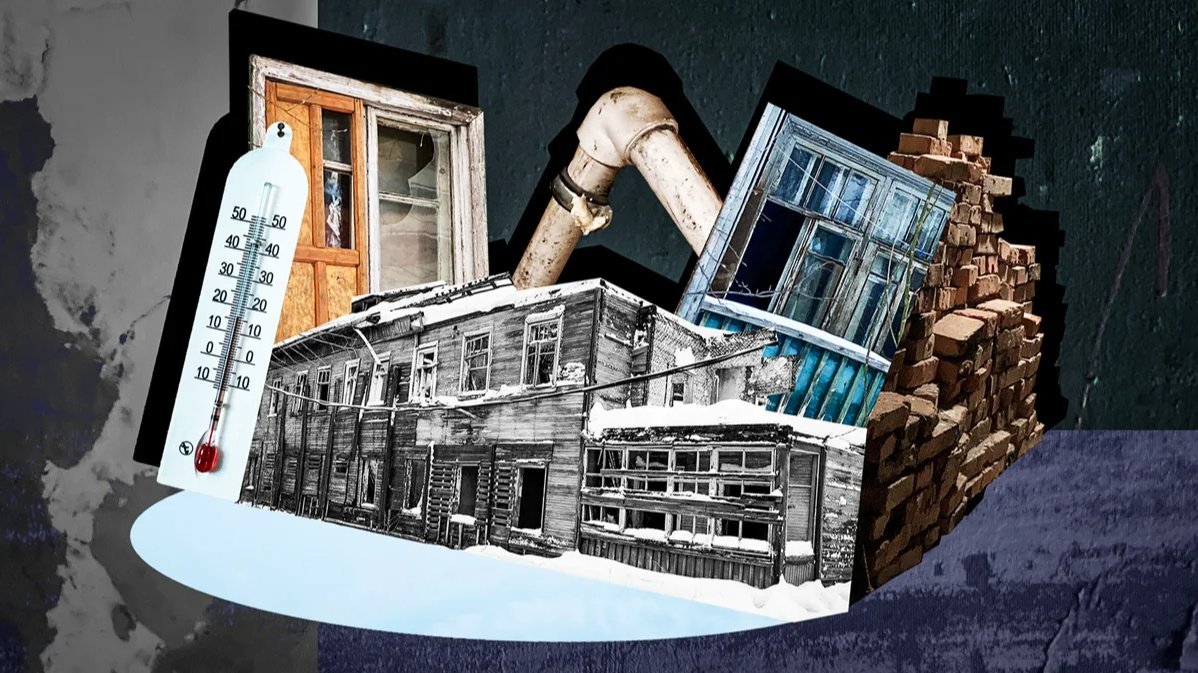In winter, it is typically just 12C inside the two-storey wooden house on Gulyaev Street in the remote northern Russian city of Arkhangelsk, and winter this far north often lasts from October to May. The water in the bathroom has to be left running at all times to prevent it freezing in the pipe. One floor recently caved in, having become completely rotten. The toilet, which had fallen through to the basement, was retrieved and propped in place using construction foam.
There are officially 6,274 condemned houses awaiting demolition in Arkhangelsk and its surrounding region. Living in them is not only deeply unpleasant, it is also dangerous. As well as catching fire and flooding, when it gets warmer during the summer months, the ground beneath them begins to thaw, the houses subside. It would cost approximately 160 billion rubles (€1.7 billion) to resettle those condemned to live in such buildings, the equivalent of what Russia spends on the war in Ukraine every five days.
Arkhangelsk is Russia’s unofficial capital of condemned housing. There are tumbledown, rotten, uninhabitable wooden houses in other Russian regions too, of course, but nowhere do they proliferate in quite the same way as they do in Arkhangelsk. The region was known as the Soviet Union’s sawmill, and the government effectively built barracks for its employees. They built hastily, from cheap materials that were readily available, timber rafted along the Northern Dvina river, and promised that as soon as communism arrived, those wooden houses would be replaced by solid stone ones.
There are now 1,763 condemned houses in the city of Arkhangelsk alone. By law, the people living in them should be resettled immediately at the state’s expense, but residents currently wait between 10–15 years to be rehoused, despite assurances from the authorities that new homes are being built apace.
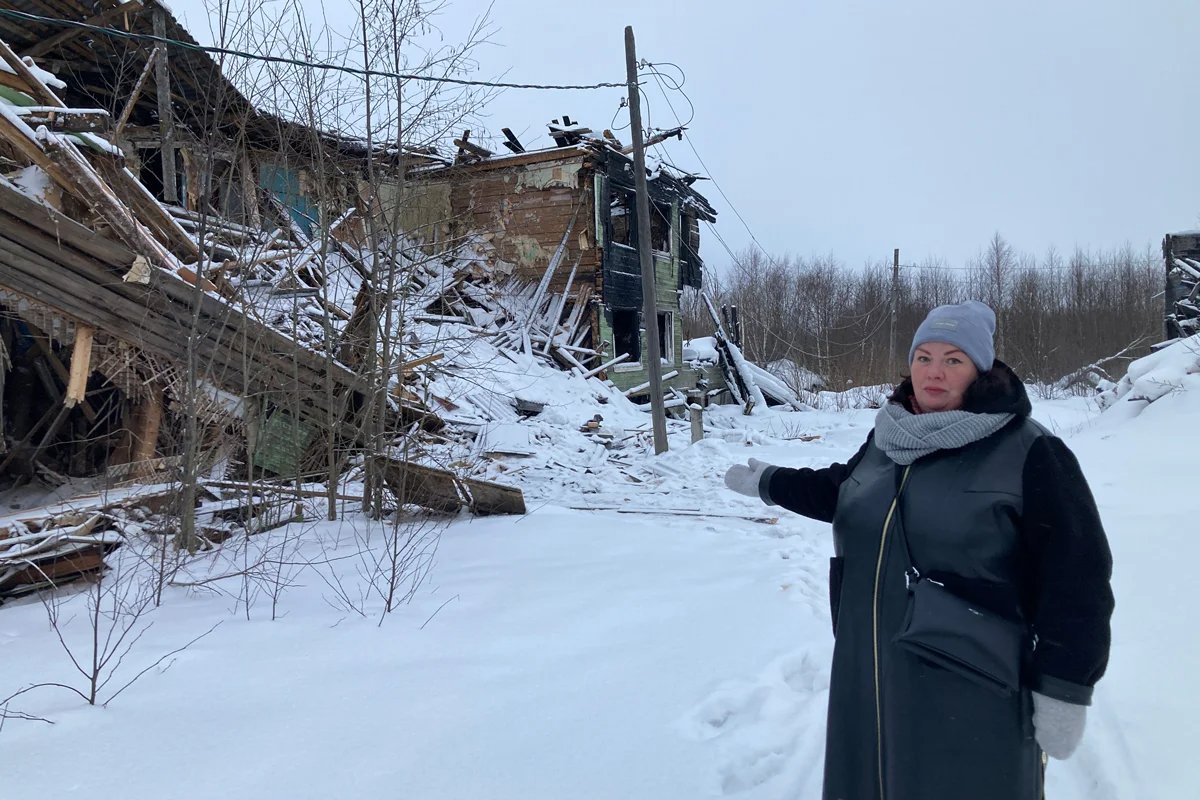
Maria Tarasova near the building on Zavodskaya Street. Photo: Irina Strelnikova
Maria Tarasova and her son lived with five other families with whom they shared a building on Zavodskaya Street. Or, rather, what remained of a building. All the residents of the building are still registered at the address.
“My room was on this side,” Tarasova says, pointing at the ruins. “Officially, we still live here. The apartments were condemned one by one in 2011, and then the whole house was declared inhabitable in 2020, when it finally came off its foundations. It caught fire in 2022.”
Tarasova now rents an apartment on the outskirts of the city, which costs her most of her salary.
*
There are wooden houses everywhere you look in Arkhangelsk, even in the city centre. Some are burnt out or completely destroyed, but more often than not, they’re still lived in, with satellite dishes and curtains on the fresh double-glazed windows. There are high-rise blocks of apartments built right next to them, but not enough apartments in them for the residents of the wooden houses next door.
“These wooden houses were built starting in the 1930s, right up until the 1980s,” says local lawyer Mikhail Vorobyov, who has been dealing with the problem of condemned housing for over 10 years, as he takes me on a tour. “These houses were built to last 25 years. In the Soviet era and the 1990s, they were looked after and maintained. But in the 2000s, no repairs were carried out.”
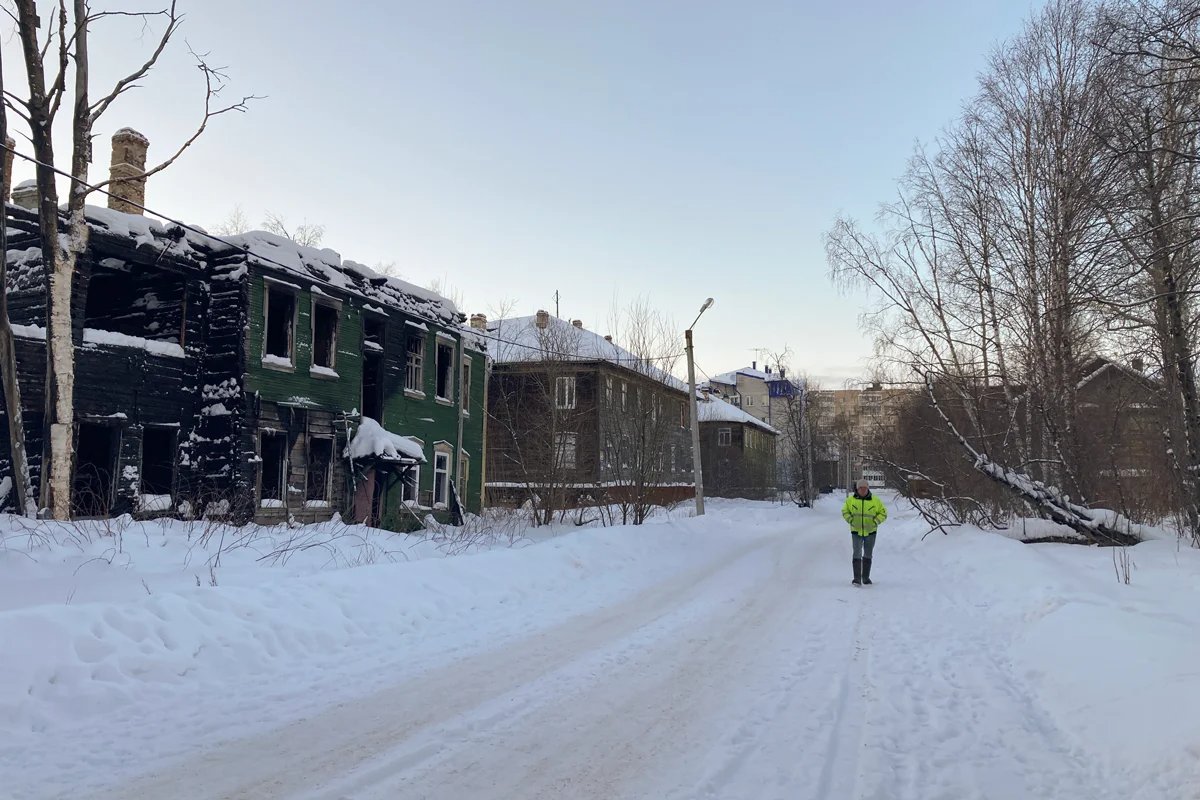
Wooden houses in Arkhangelsk. Photo: Irina Strelnikova
The authorities occasionally appear to believe that some of these houses can still be saved through renovation. No one has lived at 7 Yunosti Street for a long time, but it is still standing. Back in the 2000s, 8 million rubles (€86,000) was spent on major repairs to the building, a lot of money at the time. A year later, the house came off its foundations. People still live in the neighbouring houses.
Buildings coming off their foundations is a phenomenon peculiar to Arkhangelsk. It usually begins in June and July when the ground starts to thaw.
“The house gradually collapses, but is held up by the stone stoves for some time, and then it’s askew. It’s not a house anymore, just a set of building materials that’s dangerous to live in with rotten beams that could collapse at any time.”

7 Yunosti Street after major repairs. Photo: Irina Strelnikova
From the outside, a house may still look quite sturdy, and might still stand for another couple of months, but the people living there are in warlike conditions, ready to evacuate at any moment.
“I always tell the people living in wooden houses not to keep anything of value or their documents there,” Vorobyov continues.
The people living in a house on Kotlas Street that came off its foundations were evacuated six years ago. Irina Cherepanova got out on time with her daughter and young son, but they are still registered as living in a non-existent apartment.
*
Cherepanova is one of the unluckier ones. She owned her apartment, having bought it in 2014 when the bank wouldn’t approve a mortgage for anything better. The wooden house had looked decent at the time. She and her family have now been renting an apartment for over five years, in addition to paying the mortgage on her ruined property.
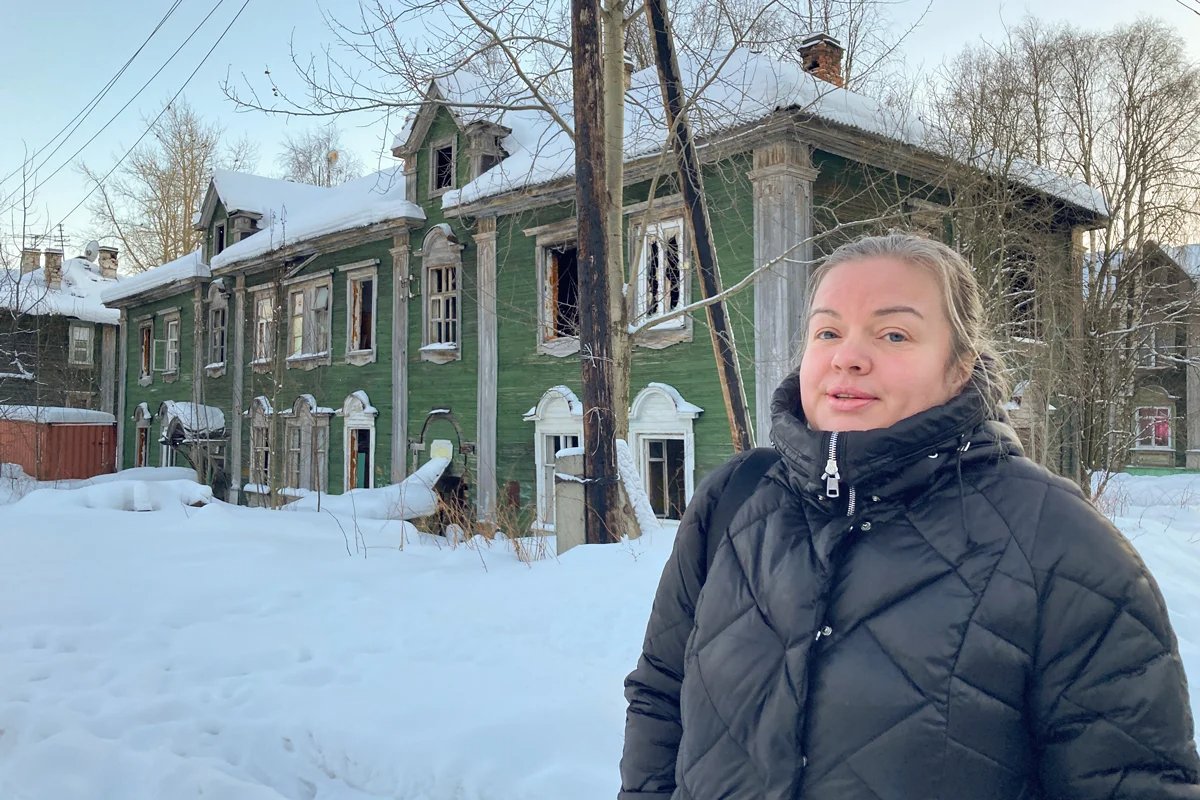
Irina Cherepanova near the house on Kotlas Street. Photo: Irina Strelnikova
“The neighbours and I noticed in June 2019 that the house was coming off its foundations,” Cherepanova recalls. “It was mostly families in the house. There must have been 12 children. They’d built a playground next to it. It was very frightening when the house collapsed.”
“I was sleeping by the kitchen window, away from the stove, so that I could get the children and myself out quickly in case something happened. So many years have passed, and I still get scared when I come here. A woman and her five sons, the youngest of whom was four, lived downstairs from us,” she continues. “When the house came off its foundations, they weren’t given temporary accommodation and had no money for rent. The mother said that she was afraid to fall asleep, because the whole house was creaking and making noise. The Emergency Situations Ministry warned them not to sleep by the stove. They were only rehoused after the eldest son hanged himself in the toilet. He was 22 and for some reason decided that he was to blame for the family not being rehoused.”
*
There are two entrances to the green two-storey house at 46 Rosa Luxemburg Street. A campaign leaflet for a local politician hangs on one door: “Compatriots, how are you living under capitalism?” the man from the Communist Party asks. One half of the house is uninhabitable in the winter, while in summer, it’s squatted by homeless people, which unsettles the four residents in the other half of the building. One front door, made of plywood, displays an “I am Russian” sticker, in reference to the patriotic hit, a Russian coat of arms and the pro-war symbols Z and V. Yelena Kychina and her 80-year-old semi-paralysed mother have two rooms here.
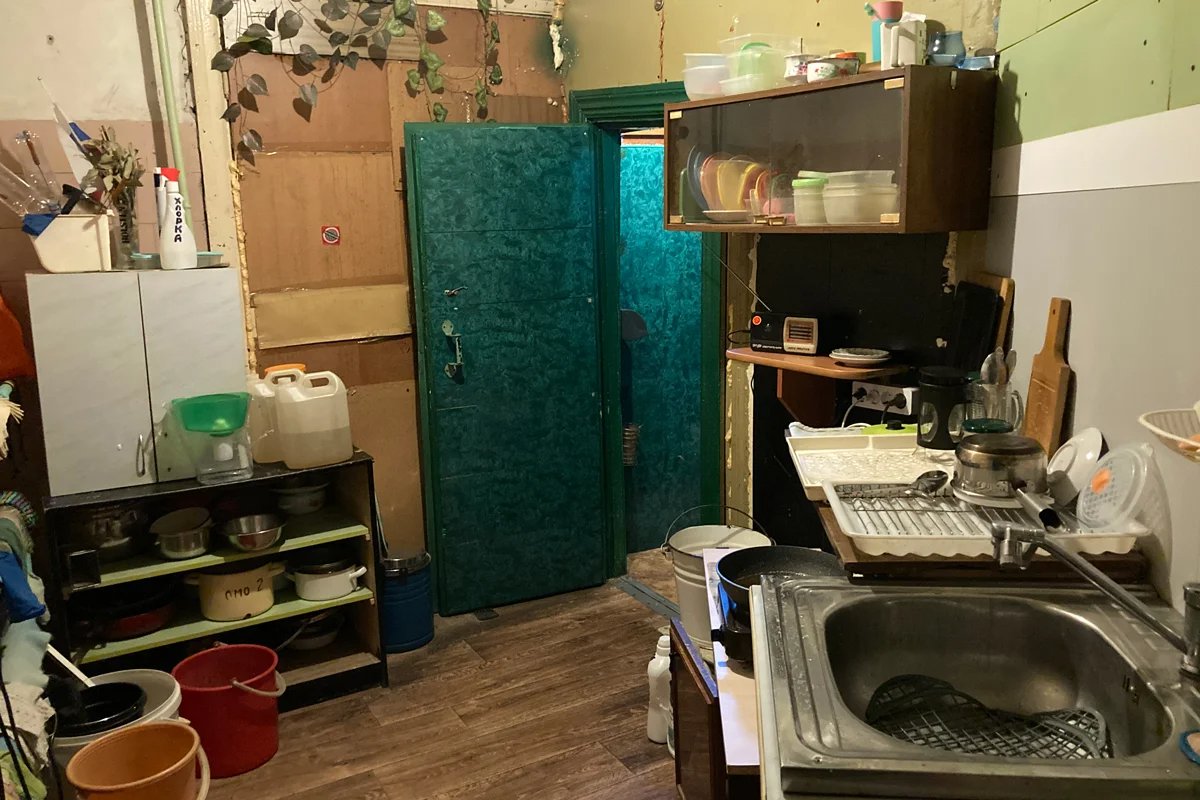
An apartment at 46 Rosa Luxemburg Street. Photo: Irina Strelnikova
“We have a shared kitchen, but don’t go there. It’s dangerous,” Kychina says as she takes me down a long dark corridor. “The beams under the floor could collapse at any minute. I only go in gingerly. I have to. The washing machine’s there. But I’m always scared the machine will fall through the floor and take me with it.”
Kychina and her mother used to live in a different wooden house on Serafimovich Street. They are still registered there, but the house is long gone, replaced by a brick mansion. Kychina jokes that she should turn up with her ID and move in.
“Our house came off its foundations,” she explains. “We were lucky to escape.”
When the house collapsed, Kychina and her mother were allocated two rooms in temporary housing, where they remain to this day.
“It was there in black and white. As the city currently has no apartments available, we suggest you temporarily move into this house,” she explains. “By law, temporary housing is given for a maximum of two years.”
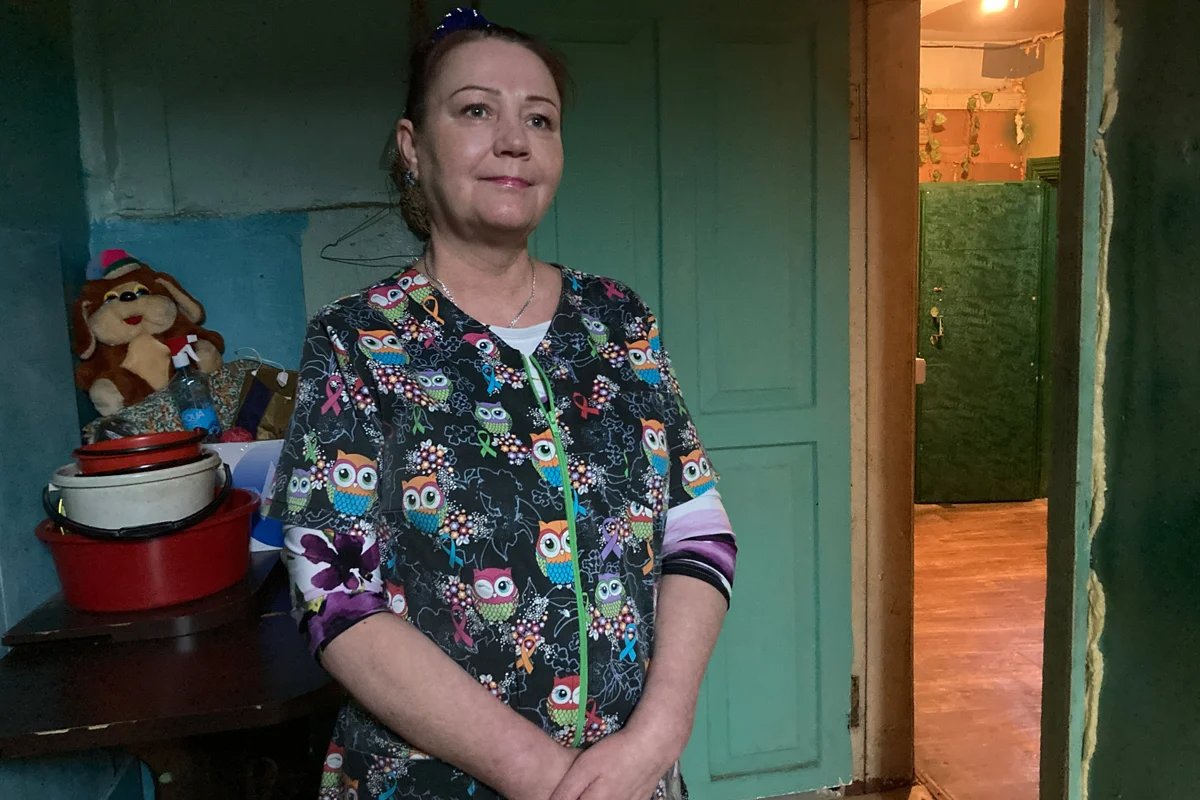
Yelena Kychina. Photo: Irina Strelnikova
That was in 1996. Now, at the age of 55, Kychina has lived over half her life in a condemned house that is now falling apart. There’s almost no running water, the heating barely works and there are holes in the walls. The utility bills can be as much as 12,000 rubles (€130) per month as its tenants are forced to use electric heaters.
Kychina works as a nurse in a large eye clinic, which just about covers the bills and food. She has repeatedly petitioned the authorities to finance purchasing some kind of house for her and her mother if an apartment was out of the question, only to be told each time that it wasn’t possible.
“I live on a powder keg,” she admits. “And my mother is sick. And I work hard. … And I need to look decent.”
*
Nadezhda, a pensioner, has a thermometer hanging on her wall at 123 Gulyaev Street. It’s currently showing 15C. She left the electric heater on all night to keep what she calls the bathroom warm so she can wash. Normally, it’s 12C at home in winter.
Nadezhda’s room is in an apartment on the ground floor. Other people used to have two rooms in the same apartment, but they scraped together the money to buy something else four years ago when they could no longer bear living in such conditions. When they left, they took all the radiators and windows with them. Those rooms now freeze and let the cold into the rest of the apartment. The local council boarded up the gaping holes and left it at that.

Nadezhda in her apartment. Photo: Irina Strelnikova
“I put an old jacket under the door, but it doesn’t help. There’s still a draft. And it’s overrun with rats. I can’t take it anymore. I’ve tried to chase them away,” Nadezha says, adding that even the rats “go hungry, though, as there’s nothing for them here”.
Last year, the local authorities appeared to take pity on Nadezhda and offered her temporary accommodation elsewhere. However, after learning that it was on the far-flung island of Brevennik, which isn’t served by transport, she decided not to even look at it.
“In winter, the only way there is to walk over the ice. I don’t know how many kilometres,” Nadezhda sighs. “I’m 70. Look at all the medication I’m on. And an ambulance won’t even go there. A woman from the council came. She looked around and said they’d fit windows. Since then, I haven’t heard a peep. How long must I live in this cold? Will I go straight from here to the cemetery?”
*
In a house on Admiral Kuznetsov Street, two friends, Yelena and Yelena Anatolyevna, live in two apartments, one above the other. Both ask me not to mention their surnames.
“A lot of people in the city know me. They’ll talk,” Yelena Anatolyevna says, in fear. “I work for the council.”

Yelena in her apartment. Photo: Irina Strelnikova
The house they live in, which was built in 1950, is not to be found in any official documents. Nor does it appear on city blueprints, which the women found in the city archive in 2003 when they were at long last connected to the water supply. Four years ago, they managed to have the building classed as condemned housing, but it still hasn’t solved their most immediate problems.
Yelena Anatolyevna’s floor collapsed in 2023. The toilet went with it, the pipe gushed water, and the place was flooded.
“We took up the floor, put down a new one, filled in any holes with foam,” Yelena Anatolyevna complains. “We did it all ourselves. There are no men here. Our stove stopped working a long time ago, and the cost of repairing it would be sky-high… We bought heaters instead. We pay a lot for electricity, but we have to live somehow.”
Both Yelena and Yelena Anatolyevna have been promised new housing in about 2027, or maybe even 2030.

Inside Yelena Anatolyevna’s apartment. Photo: Irina Strelnikova
“These are purely speculative terms,” Vorobyov says, shaking his head. “If the house was condemned in 2021, then add 10, maybe 15 years.”
A fly swatter and a flag in the shape of the letter Z hang in Yelena Anatolyevna’s hallway, something she takes to the pro-war events she attends. There is a pretty picture hung on a nail on the wall, and underneath that, in a gilded frame, a portrait of Vladimir Putin, reminiscent of an icon.
“It’s not ironic,” Yelena Anatolyevna says, giving me an earnest look. “I wish him a happy birthday and a long life every year. I write to him about the situation we’re in, but I haven’t had a response yet. But I’m not angry at him. It’s not like he can keep an eye on all the officials not doing their jobs. I have real respect for him. I think he’s our guardian angel.”
